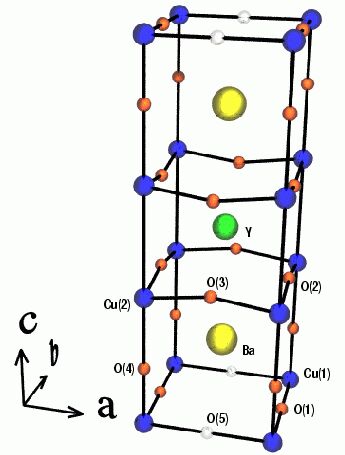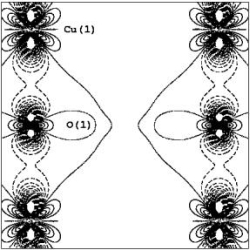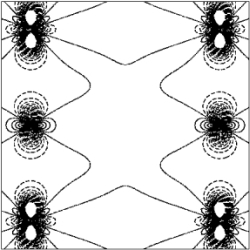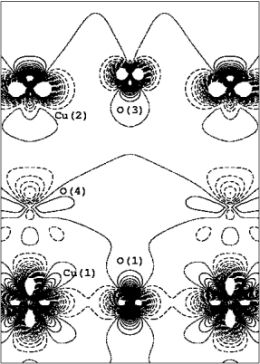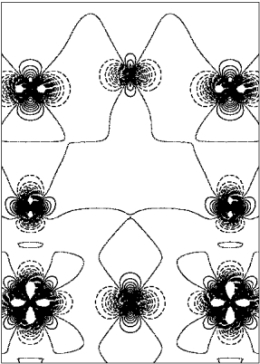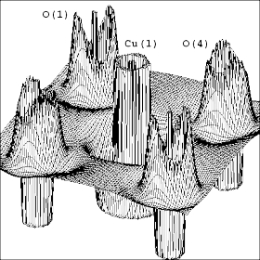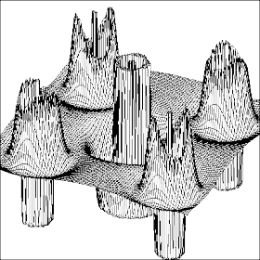Fig. 2:
Thomas Lippmann1, Peter Blaha2, Niels Hessel Andersen3, Henning Friis Poulsen3, Thomas Wolf4, Jochen R. Schneider5, Karl-Heinz Schwarz2
1GKSS Forschungszentrum, D-21502 Geestacht, Germany
2Technical University Wien, Institute for Material Chemistry, A-1060 Wien, Austria
3Risø National Laboratory, Materials Research Department, DK-4000 Roskilde, Denmark
4Forschungszentrum Karlsruhe, IFP, D-76021 Karlsruhe, Germany
5 HASYLAB at DESY, D-22603 Hamburg, Germany
Published in: Acta Cryst. A59, 437-451, 2003
Charge density investigations play an important role in order to determine the crystalline and electronic structures of materials. Theoretical models are usually tested by experimental data, but up to now this was difficult for high-Tc superconductors. Using high-energy synchrotron radiation, structure factors of YBa2Cu3O6.98 were measured at lambda = 0.124 A. Experimental and theoretical results generally agree well. A topological analysis shows that the structure is mainly ionic, but depletion of charge density between Cu and O gives hints for covalency, and confirms the general consensus of hole localization in these bonds.
Intention
Charge density investigations play an important role in order to determine crystalline and intricate electronic structures of materials [1]. Theoretical models are often tested by experimental data, but up to now this was difficult for high-Tc superconductors , because large absorption and extinction prevented measurements of reliable data. We used high-energy synchrotron radiation of 100 keV, where absorption and extinction are generally small, in order to obtain high-quality experimental structure factors [2-5].
Structure
According to the phase diagram, YBa2Cu3O6+x crystallizes in either a superconducting, orthorhombic or an antiferromagnetic, tetragonal structure depending on the oxygen content x of the sample. The structure is a distorted perovskite and can be considered as consisting of several layers stacked along the c axis (Fig. 1):
CuO layer: Cu(1)-O(1) chains along the b axis, O(5) is empty in the fully oxidized structure.
BaO layer: Ba in the middle of four O(4) atoms
CuO2 layer: Cu(2), O(2) and O(3). Also called superconducting plane.
Y layer
The phase transition temperature of the fully oxidized samples is about 90 K [6].
Results
Theoretical and experimental charge densities generally agree well. The structure is dominated by ionic forces, but small covalent contributions were also found. Fig. 2 shows static deformation densities, i.e. the spherical parts of the charge densities are omitted. Both maps show charge depletions along the bond paths between the atoms. The deformation density of the copper atoms give strong evidence for unoccupied, antibonding dx2-y2 orbitals along the Cu-O bonds and occupied dz2 , dxy , dxz and dyz orbitals, respectively, pointing versus the structural voids. As expected, this effect is more pronounced the shorter the respective Cu-O bonds are, since for shorter bonds the bonding-antibonding splitting is expected to be larger leading to even less occupation of the antibonding orbital.
In addition to the general agreement between theoretical and experimental charge densities some differences were also found. Fig. 3 indicates a lone-pair at the Cu(2) in the experimental data and also some polarization of the charge density at the oxygen atoms, which are nearly absent in the theoretical maps. While the deformation of the copper has already been reported by other investigators [7], the oxygen deformations still have to be further examined.
A quantitative investigation of the bonding in YBa2Cu3O6.98 was performed by means of a topological analysis according to the Quantum Theory of Atoms in Molecules (AIM) [8,9]. The charge densities and Laplacians at the critical points underline the ionic-dominated character of the bonds. Similar results are obvious in the Laplacian maps (Fig. 4) of the valence shells, i.e. the maps indicate a two-fold symmetry in the oxygen valence shells and charge concentrations approximately perpendicular to the Cu-O bonds.
| References |
|
[1] W.E. Pickett. Electronic structure of the high-temperature oxide superconductors. Rev. Mod. Phys.61, 433 - 512 (1989) |
| Contact information |
|
T. Lippmann (GKSS Outstation at DESY) |
| Further Information |





